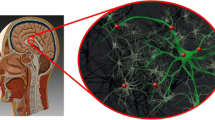Abstract
The presence of the blood–brain barrier (BBB) makes extremely difficult to develop efficacious strategies for targeting contrast agents and delivering drugs inside the Central Nervous System (CNS). To overcome this drawback, several kinds of CNS-targeted nanoparticles (NPs) have been developed. In particular, we proposed poly-lactide-co-glycolide (PLGA) NPs engineered with a simil-opioid glycopeptide (g7), which have already proved to be a promising tool for achieving a successful brain targeting after i.v. administration in rats. In order to obtain CNS-targeted NPs to use for in vivo imaging, we synthesized and administrated in mice PLGA NPs with double coverage: near-infrared (NIR) probe (DY-675) and g 7. The optical imaging clearly showed a brain localization of these novel NPs. Thus, a novel kind of NIR-labeled NPs were obtained, providing a new, in vivo detectable nanotechnology tool. Besides, the confocal and fluorescence microscopy evidences allowed to further confirm the ability of g 7 to promote not only the rat, but also the mouse BBB crossing.







Similar content being viewed by others
References
Bandettini PA (2009) What’s new in neuroimaging methods? Ann NY AcadSci 1156:260–293
Brambilla D, Nicolas J, Le Droumaguet B, Andrieux K, Marsau V, Couraud PO, Couvreur P (2010) Design of fluorescently tagged poly(alkyl cyanoacrylate) nanoparticles for human brain endothelial cell imaging. Chem Commun 46:2602–2604
Costantino L, Gandolfi F, Tosi G, Rivasi F, Vandelli MA, Forni F (2005) Peptide-derivatized biodegradable nanoparticles able to cross the blood–brain barrier. J Control Rel 108:84–96
Costantino L, Gandolfi F, Bossy-Nobs L, Tosi G, Gurny R, Rivasi F, Vandelli MA, Forni F (2006) Nanoparticulate drug carriers based on hybrid poly(d,l-lactide-co-glycolide)-dendron structures. Biomaterials 26:4635–4645
Dhanasekaran M, Palian M, Alves I, Yeomans L, Keyari CM, Davis P, Bilsky EJ, Egleton RD, Yamamura HI, Jacobsen NE, Tollin G, Hruby VJ, Porreca F, Polt R (2005) Glycopeptides related to b-endorphines adopt helical amphipathic conformation in the presence of lipid bilayers. J Am Chem Soc 127:5435–5448
Fessi H, Puisieux F, Devissaguet JP, Ammoury N, Benita S (1989) Nanocapsule formation by interfacial polymer deposition following solvent displacement. Int J Pharm 55:R1–R4
Gref R, Minamitake Y, Peracchia MT, Trubetskoy V, Torchilin V, Langer R (1994) Biodegradable long-circulating polymeric nanospheres. Science 263:1600–1603
Hillman EMC (2007) Optical brain imaging in vivo: techniques and applications from animal to man. J Biomed Opt 12(051402):1–28
Hu R, Yong KT, Roy I, Ding H, Law WC, Cai H, Zhang X, Vathy LA, Bergey EJ, Prasad PN (2010) Functionalized near-infrared quantum dots for in vivo tumor vasculature imaging. Nanotechnology 21. doi:10.1088/0957-4484/21/14/145105
Inoue Y, Izawa K, Kiryu S, Tojo A, Ohtomo K (2008) Diet and abdominal autofluorescence detected by in vivo fluorescence imaging of living mice diet. Mol Imaging 7:21–27
Michalet X, Pinaud FF, Bentolila LA, Tsay JM, Doose S, Li JJ, Sundaresan G, Wu AM, Gambhir SS, Weiss S (2005) Quantum dots for live cells, in vivo imaging, and diagnostics. Science 307:538
Polt R (2005) Glycosylated neuropeptides: a new vista for neuropharmacology? Med Res Rev 25:557–585
Polt R, Palian MM (2001) Glycopeptide analgesics. Drugs Future 26:561–576
Prilloff S, Fan J, Henrich-Noack P, Sabel BA (2010) In vivo confocal neuroimaging (ICON): non-invasive, functional imaging of the mammalian CNS with cellular resolution. Eur J Neurosci 31:521–528
Tanisaka H, Kizaka-Kondoh S, Makino A, Tanaka S, Hiraoka M, Kimura S (2008) Near-infrared fluorescent labeled peptosome for application to cancer imaging. Bioconj Chem 19:109–117
Tosi G, Rivasi F, Gandolfi F, Costantino L, Vandelli MA, Forni F (2005) Conjugated poly(d, l-lactide-co-glycolide) for the preparation of in vivo detectable nanoparticles. Biomaterials 26:4189–4195
Tosi G, Costantino L, Rivasi F, Ruozi B, Leo E, Vergoni AV, Tacchi R, Bertolini A, Vandelli MA, Forni F (2007) Targeting the central nervous system. In vivo experiments with peptide derivatized nanoparticles loaded with loperamide and rhodamine 123. J Control Rel 122:1–9
Tosi G, Vergoni AV, Ruozi B, Bondioli L, Badiali L, Rivasi F, Costantino L, Forni F, Vandelli MA (2010) Sialic acid and glycopeptides conjugated PLGA nanoparticles for central nervous system targeting: in vivo pharmacological evidence and biodistribution. J Control Rel 145:49–57
Vergoni AV, Tosi G, Tacchi R, Vandelli MA, Bertolini A, Costantino L (2009) Nanoparticles as drug delivery agents specific for CNS: in vivo biodistribution. Nanomedicine 5:369–377
Wang ZH, Wang ZY, Suna CS, Wang CY, Jianga TY, Wang SL (2010) Trimethylated chitosan-conjugated PLGA nanoparticles for the delivery of drugs to the brain. Biomaterials 31:908–915
Xu Z, Pilch DS, Srinivasan AR, Olson WK, Geacintov NE, Breslauer KJ (1997) Modulation of nucleic acid structure by ligand binding induction of a DNA-RNA-DNA hybrid triplex by DAPI intercalation. Bioorg Med Chem 5:1137–1147
Acknowledgments
The authors thank Luca Fabiani for microtome cut, Dr. Stefania Bettelli for the help in DAPI staining and Andrea Lorenzon for animal preparation. We also thank Prof. Luca Costantino for the synthesis of g7-PLGA polymer and Dr. Andrea Tombesi, CIGS (Centro Interdipartimentale Grandi Strumenti) of the University of Modena and Reggio Emilia for assistance in confocal analysis. This work is supported by Azzurra, Associazione Malattie Rare O.N.L.U.S.
Author information
Authors and Affiliations
Corresponding author
Rights and permissions
About this article
Cite this article
Tosi, G., Bondioli, L., Ruozi, B. et al. NIR-labeled nanoparticles engineered for brain targeting: in vivo optical imaging application and fluorescent microscopy evidences. J Neural Transm 118, 145–153 (2011). https://doi.org/10.1007/s00702-010-0497-1
Received:
Accepted:
Published:
Issue Date:
DOI: https://doi.org/10.1007/s00702-010-0497-1




